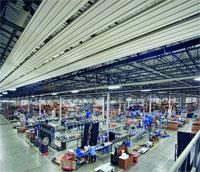Zehnder - What are EN Standards?
 Zehnder - What are EN Standards?
Zehnder - What are EN Standards?
European Standards (ENs) are documents that have been ratified by one of the three European Standardization Organisations (ESOs), CEN, CENELEC or ETSI; recognised as competent in the area of voluntary technical standardisation as for the EU Regulation 1025/2012.
What are the key industry standards that relate to heating and cooling surfaces (radiant panels)?
EN-Standard
EN 14240 cooling capacity of closed ceiling
EN 14037-2 thermal output of radiant panels
EN 14037-4 cooling capacity of radiant panels
EN 14037-5 thermal output of open or closed heated ceiling
What has changed?
Since November 2016, EN 14037-4 cooling capacity of radiant panels and EN 14037-5 thermal output of open or closed heated ceilings, developed by the EMCP (European Manufacturers of Ceiling Panels) have superseded the previous standards. Although the standards remain voluntary rather than mandatory they are recognised across the industry.
How does this impact testing methodology?
Manufacturers would typically have tested radiant panels using the EN 14037-2 testing methodology whether panels were installed as either ceiling panels (free hanging or ceiling sails) or within a ceiling grid or lay-in (termed solely ceiling grid from this point forwards) application. The new standard, EN 14037-5, ensures a separate testing methodology is used for ceiling grid applications.
EN 14037-4 has been implemented by the EMCP to provide a standard for cooling capacity of radiant panels replacing the existing EN 14240 which was developed as part of a ‘Ventilation for buildings’ methodology. As a note when manufacturers test to EN 14037 2 (thermal output – 3 point measuring) the testing to EN 14037-4 (cooling capacity) is carried out directly afterwards as a single point measure.
When should testing to EN 14037-2 and EN 14037-5 be used?
EN 14037-2 is used when ceiling panels are installed, typically in large enclosure applications, when designed as long strips. You can expect higher system temperatures than when compared with ceiling grids. Output results will be based on W/m.
EN 14037-5 is used when radiant panels are installed within ceiling grids, typically where low mounting heights are concerned. You can expect lower system temperatures than when compared with ceiling panels. Output results will be based on W/m².
If the ceiling panel heat output is taken according to EN 14037-2 standard for a grid application, it leads to considerable more output than what the panel can transfer in reality in that application. Hence the requirement for the EN 14037-5 standard. This article solely concerns itself with thermal output (heating) rather than cooling.
EN 14037-2 (in W/m) and EN 14037-5 (in W/m²) derived?
Firstly, we need to determine what is considered the ‘active surface’ of both a ceiling panel or ceiling grid to provide the necessary output information. We need to consider the active surface in accordance with EN 14240 standard, that considers the active length – i.e the part of the panel where the water carrying pipes are in thermal contact with the radiant panel and the heat exchanger strip between pipe and panel plate (e.g. the aluminium foil) – whichever is longer. The active width is derived by multiplying the number of pipes by the spacing between each pipe (shown as calculation 4 x b, below). By adopting the active surface area defined in the EN 14240 standard, it allows for appropriate scaling for heating output to be accounted for. This differs from EN 14037-5 testing standard, which considers the active surface to be the whole module (or panel) area, when installed within a ceiling grid and would not provide the output of the active area. So the active surface is calculated by active length x active width. Calculating heat output using EN 14037-2 is a simple process based on the dimensions of the ceiling panel – for each panel there is a specific heat output in W/m.
What do you need to do?
When working with manufacturers ensure they are both working to the new standards and applying the relevant standard to the type of application, either as ceiling panels or ceiling grids. This will ensure that you achieve the stated outputs you are looking to achieve and heat outputs can be compared between manufacturers, on a like for like basis. Heat outputs derived under EN 14037-5 standard will be lower than for EN 14037-2 when the flow temperature is >50°C, as a factor of 1.1 is used (for EN 14037-2) in output claims (referenced in EN 14037-3 Free hanging heating and cooling surfaces for water with a temperature below 120°C) when the flow temperature is >50°C.
When working with manufacturers ensure they are both working to the new standards and applying the relevant standard to the type of application, either as ceiling panels or ceiling grids. This will ensure that you achieve the stated outputs you are looking to achieve and heat outputs can be compared between manufacturers, on a like for like basis. Heat outputs derived under EN 14037-5 standard will be lower than for EN 14037-2 when the flow temperature is >50°C, as a factor of 1.1 is used (for EN 14037-2) in output claims (referenced in EN 14037-3 Free hanging heating and cooling surfaces for water with a temperature below 120°C° when the flow temperature is >50°C.
Why would manufacturers opt for stating heat outputs to old standards rather than adopt new standards or not even referencing standards?
The standards themselves are a voluntary technical standardisation so not enforceable. However, adopting them will ensure a consistent approach and provide comparable data across the industry. It will ensure professional standards are maintained, in that a building will achieve its thermal design conditions as a result of all plant and equipment performing as stated in manufacturer’s documentation. If a test standard is not stated it is a fair assumption that outputs are not worth the paper they are written on and should not be accepted without validation.